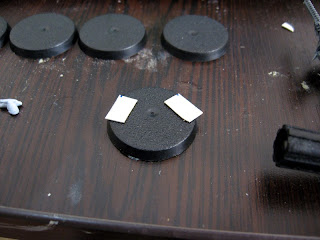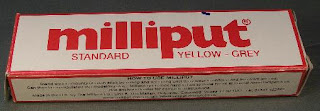Once the texture paste is dry, it was time to start painting (or drybrushing)
First I did a layer of dark grey, then mid grey, and finally light grey. Last touch was done with almost pure white. The card was also painted dark grey, and later on stippled with lighter grey (not shown in the photos unfortunately).
The exact colors i used are:
1. Dark Grey = codex grey : chaos black : ultramarine blue in 2:1:1 ratio
2. Mid grey = codex grey : ultramarine blue in 2:1 ratio
3. Light grey = codex grey : ultramarine blue : skull white in 2:1:1 ratio
The light grey is curiously similar to Space Wolves Grey, so I guess i could have used that as well. The actual paint used is Americana craft acrylic paint that I use for all bulk work. Codex grey is called Slate Gray, and Chaos Black is Lamp Black in that rage. Ultramarine blue is still Ultramarine (smurf) blue
When the bases were all drybrushed and nice, I painted the rims in pure black, drilled pins for each model, and stuck them on the base.
The snow product used is the Army Painter Battlefields show mixed with generic white pva glue
I applied the snow paste in a blob. spread it with a wooden spatula, and once I was happy with how it looks, I just dipped it in snow flock tub. The results are pretty nice as you can see :)
This would sum up the tutorial for 25mm snow bases :)
Friday, September 9, 2011
25mm snow bases tutorial pt. 1
Taken as-is from my blog. Even though Gareson doesn't really like the models I use here, or the company that makes them, I love to play around with them :)
When working with 25mm bases, there is not much to do with them, considering their small size, and the way most models connect to them, effectively taking 30% of the surface, or even more.
For this squad of Space Wolves I decided to make simple rough terrain covered with snow.
The first and most important part is to make raised for the minis, so they dont look like they are sinking into the ground.
I start it off with the bases, and a strip of card cut from the super glue packaging (recycle as much as you can is my moto!)
To position it all i Use little blobs of blu-tack on the model's feet
Stick the card squares that more or less match the size of model feet
And glue it to the base.
Remove the model, remove the blu-tack, and you have your base with the raiser.
Finally just trim the raiser to fit the base
Here are all of the bases with their raisers:
One of the reasons I take these photos, is to easily match the model to its base once the bases are done :)
The texture on the bases is done with some simple textured craft paint. I use the black one since its easily drybrushed to lighter shade, and black out of the box is a very good to simulate paved roads:
And here are some bases with the texture applied. Now just to wait for the texture to dry, and I can go on painting and applying snow :)
When working with 25mm bases, there is not much to do with them, considering their small size, and the way most models connect to them, effectively taking 30% of the surface, or even more.
For this squad of Space Wolves I decided to make simple rough terrain covered with snow.
The first and most important part is to make raised for the minis, so they dont look like they are sinking into the ground.
I start it off with the bases, and a strip of card cut from the super glue packaging (recycle as much as you can is my moto!)
To position it all i Use little blobs of blu-tack on the model's feet
Stick the card squares that more or less match the size of model feet
And glue it to the base.
Remove the model, remove the blu-tack, and you have your base with the raiser.
Finally just trim the raiser to fit the base
Here are all of the bases with their raisers:
One of the reasons I take these photos, is to easily match the model to its base once the bases are done :)
The texture on the bases is done with some simple textured craft paint. I use the black one since its easily drybrushed to lighter shade, and black out of the box is a very good to simulate paved roads:
And here are some bases with the texture applied. Now just to wait for the texture to dry, and I can go on painting and applying snow :)
Friday, August 26, 2011
Well its a start....
by Arithon
Basing tutorial
This is just a little tutorial on how I build my bases and includes some of materials that I commonly use. It is important to note that I have found a few things that are keys points for basing I think. Firstly setting is important- for these I have gone for a bushland/ warzone type of area, it isn’t perfect by far but suits doing things like mass miniature bases. Secondly the having a variety of materials/ textures help both with painting and makes the base interesting. Nearly anything that can be used for basing either natural products such as twigs and pine bark to other bits and pieces. The main thing I use to keep this altogether is kneadit epoxy putty. I buy this form my local hardware store and it costs about $20 for a 25cm roll but to base all these miniatures only took half a roll. It sets very rapidly and can be worked with a sculpting tool dipped into a bit of water. It isn’t really suitable for sculpting but is great for basing or even filler in other larger metal miniature projects.
Firstly I pick items that I think might fit the base like small rocks, bits of wood (pine bark is great), hirst blocks (plaster) and in this case a cog. Now the key to keeping everything together is knead it putty. This is two parts epoxy putty that is commonly used in filling gaps in building. You just cut off a small piece as show and then place a small ball on the centre of the base (no glue is need in most cases), now you have to work quickly and place the materials into this putty. Once placed (no glue again), just use your sculpting tool (knife end), to move it around and tighten it up between the gaps and any overhang that you don’t want. To make it easier to work just dip the putty in water so it does stick to your hands or the tool. Be quick though this stuff sets rock hard in five minutes. Once finished add some PVA glue in some of the joins and add any sand you might want for added texture but use a brush for more control. Finally add sand. The miniature is finally added by pinning to the base- all these materials can be drill very easily and then attach the miniature with super glue. If it does fit perfectly- either build it up a bit around the feet with small pieces of rock or something else you think might fit.


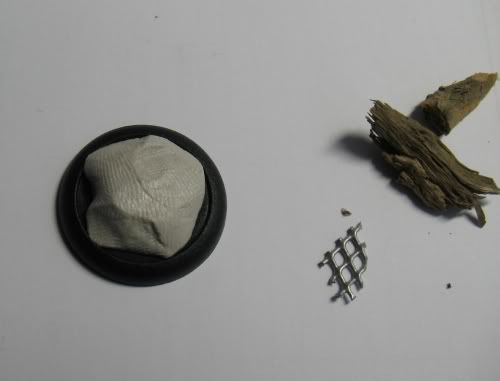
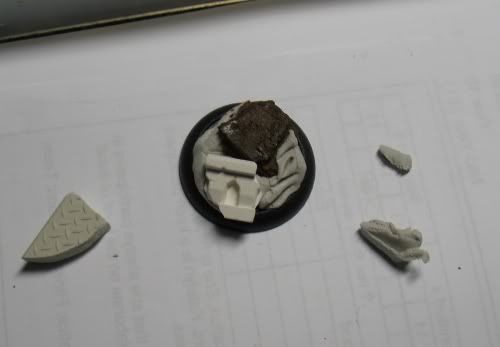



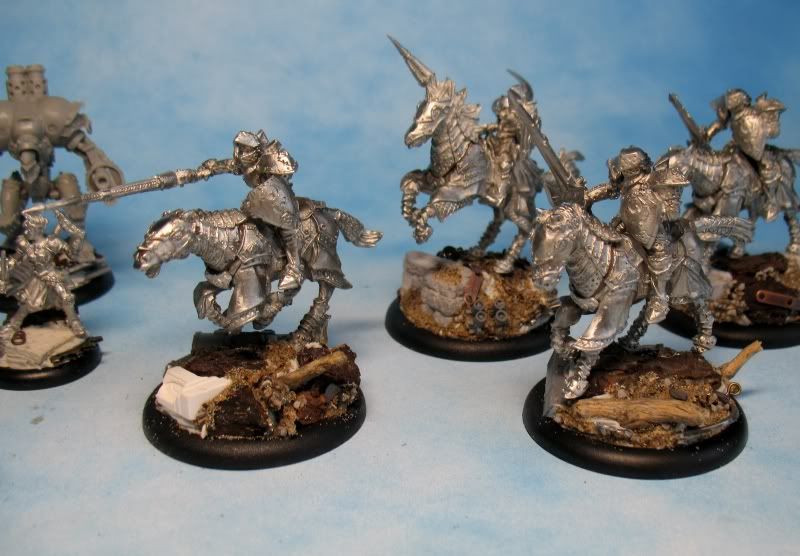
Examples of finished project's that I did earlier this year......
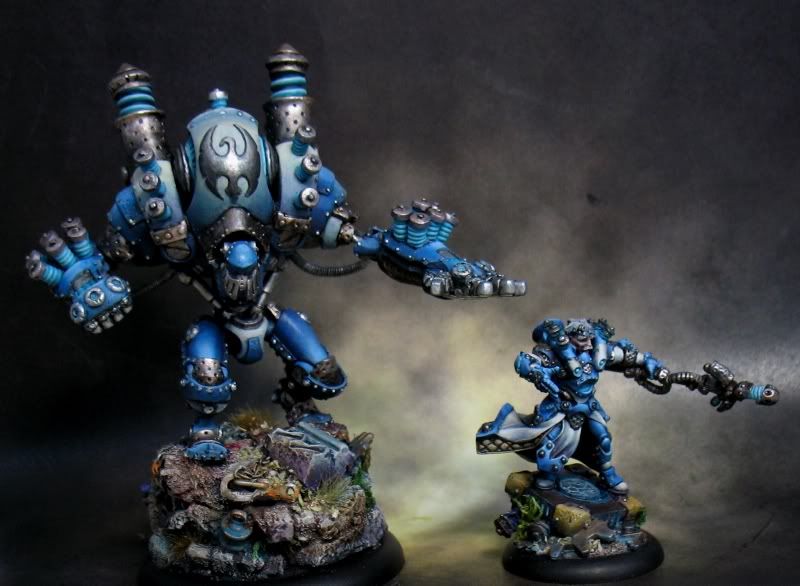

Basing tutorial
This is just a little tutorial on how I build my bases and includes some of materials that I commonly use. It is important to note that I have found a few things that are keys points for basing I think. Firstly setting is important- for these I have gone for a bushland/ warzone type of area, it isn’t perfect by far but suits doing things like mass miniature bases. Secondly the having a variety of materials/ textures help both with painting and makes the base interesting. Nearly anything that can be used for basing either natural products such as twigs and pine bark to other bits and pieces. The main thing I use to keep this altogether is kneadit epoxy putty. I buy this form my local hardware store and it costs about $20 for a 25cm roll but to base all these miniatures only took half a roll. It sets very rapidly and can be worked with a sculpting tool dipped into a bit of water. It isn’t really suitable for sculpting but is great for basing or even filler in other larger metal miniature projects.
Firstly I pick items that I think might fit the base like small rocks, bits of wood (pine bark is great), hirst blocks (plaster) and in this case a cog. Now the key to keeping everything together is knead it putty. This is two parts epoxy putty that is commonly used in filling gaps in building. You just cut off a small piece as show and then place a small ball on the centre of the base (no glue is need in most cases), now you have to work quickly and place the materials into this putty. Once placed (no glue again), just use your sculpting tool (knife end), to move it around and tighten it up between the gaps and any overhang that you don’t want. To make it easier to work just dip the putty in water so it does stick to your hands or the tool. Be quick though this stuff sets rock hard in five minutes. Once finished add some PVA glue in some of the joins and add any sand you might want for added texture but use a brush for more control. Finally add sand. The miniature is finally added by pinning to the base- all these materials can be drill very easily and then attach the miniature with super glue. If it does fit perfectly- either build it up a bit around the feet with small pieces of rock or something else you think might fit.








Examples of finished project's that I did earlier this year......


Thursday, August 25, 2011
Half Brick Easy Basing Tutorial
by Gareson
I often see, either on the gaming table or the internet, painted minis that are finished up except for basing. Now of course for the fanciest basing you'll really need to pre-sculpt or integrate the details ahead of time(see some of Adary's great articles on Just the Bases). However, if your mini is all painted up and glued onto the base, there are still some nice basing effects can you achieve "around" the planted mini. There's always simple basing with sand(see this article), but one of my favorites is something I call the "Half Brick" or "Ruined Road" effect. The concept here is that the base depicts a decayed roadway or tiled chamber which has eroded so that earth or dirt covers half of the base.
For this tutorial I am going to use a Daughter of the Flame mini from Privateer Press(Warmachine). She's all painted up(more or less) but needs a nice base. Now of course PP bases, as with most miniature companies, are black discs...mine only appears grey because I glued the figure onto the base before I used my grey primer:
In the pic above you can clearly see the indentation where the metal tab on the bottom of the mini inserts into the "slot" on the base. Obviously our basing effect will need to erase that(which it will).
I like Milliput because it is a simple two part putty that is easy to mix, work with, and, most importantly, dries and hardens fairly quickly. Within a couple of hours of mixing and applying the Milliput you can paint over it(something like Green Stuff would take longer).
I mix up a little bit of Milliput and I apply a small ball to the base on the side where I want the brick. Now certainly you could carefully work around the mini's feet and do the entire base in 'brick', but again, I'm doing a "Ruined Road" style. With your finger and/or the flat side of an x-acto knife blade, work the Milliput into a flat shape that covers roughly half the base. I would suggest wetting your fingers or knife blade with a little water because the Milliput is a little tacky.
You'll notice that I've not completely covered the slot on the base; this is not a problem because our sand texture will take care of that later.
Now I take my x-acto knife and cut vertical lines in to establish the rows of bricks...making the lines roughly parallel and equidistant from one another. Try not to push too hard all the way to the base as you carve these lines as you could cause the Milliput to shift and separate...just gently scribe in the lines.
Now I have gone back with the knife and etched in the horizontal(well really they are at a 45 degree angle in the photo) lines to create the separate bricks of this road(or chamber floor). At this point the brick effect looks pretty good but to create a little more of a rough stone or weathered effect...
I use and old drybrush and lightly stipple indentations into the Milliput surface. I can also make larger dents, or even cracks, with the x-acto knife. The photo doesn't show it on this bright Milliput, but there are some nice surface irregularities that will show up layer with a wash(see below).
After a couple of hours after applying the Milliput(with a little help from hot lamps), I basecoat the brick surface with Reaper's Tusk Ivory from their HD series of paints(any light tan would do the same thing). The wet paint above is not very visible, nor are the brick details, but we'll fix that with the next step.
After the basecoat is completely dry, I thin down(with water) some Sepia Ink from Vallejo's Game Colors line. I generously apply this over my bricks and make sure the entire surface gets this wash. The details in the bricks are starting to pop now...including the irregularities that we stippled in. You could go back and drybrush on your basecoat color to highlight the raised details(or even line/block in some shading), but we'll keep it simple here. Of course if you were simulating grey stone bricks I would suggest a light grey basecoat followed by a black wash.
After the brick "wash" has completely dried, take watered-down glue(or Mod Podge is my preference) and apply it to the other half of the mini's base. Make sure you not only cover the entire non-brick side, but that you overlap a little and apply some adhesive over the edge of the brick(as shown above).
Dip your miniature in sand, blow off any loose grit, and now you have texture on the other half of your base.
I use a simple approach of (1)Dark Brown Basecoat (2)Dark Tan Highlight and a (3)Light Tan Highlight. In the pic above you can see the three particular paints I used(P3 Battlefield Brown, Beast Hide and Menoth White Base)...but any substitutes would work just as well. The highlights were simply applied used dry-brushing to bring out the texture of the sand(dirt).
Step 5: Paint the Base Lip
Well, with all that Milliput, sand and paint, the lip of your base needs to be cleaned up to finish your model(especially as mine was primed grey as previously mentioned). At this point you want to find a nice black(I like Reaper Pro Series Faded Black) and paint the lip or round edge of your base. It's not shown here, but I attach my mini to a temporary stand(poster putty on top of an old paint pot) so I can get all around the base neatly.
In the end, here is the final effect...
Now the tutorial above may make this seem like a long process but to be honest it is quick, easy and painless. I personally think its a great way to give an already painted and mounted miniature a respectful base with a little something beyond just dirt texture. In the end you could add a little foliage or moss to the base...but I like the simple, desolate look of the base as is in most cases.
***Update*** Added a three part video tutorial for the effect above...
(double click on videos to enlarge them)
I hope you found this tutorial helpful and can make use of it in the future...thanks for reading/viewing!
Happy Wargaming Everybody,
~Gareson
I often see, either on the gaming table or the internet, painted minis that are finished up except for basing. Now of course for the fanciest basing you'll really need to pre-sculpt or integrate the details ahead of time(see some of Adary's great articles on Just the Bases). However, if your mini is all painted up and glued onto the base, there are still some nice basing effects can you achieve "around" the planted mini. There's always simple basing with sand(see this article), but one of my favorites is something I call the "Half Brick" or "Ruined Road" effect. The concept here is that the base depicts a decayed roadway or tiled chamber which has eroded so that earth or dirt covers half of the base.
For this tutorial I am going to use a Daughter of the Flame mini from Privateer Press(Warmachine). She's all painted up(more or less) but needs a nice base. Now of course PP bases, as with most miniature companies, are black discs...mine only appears grey because I glued the figure onto the base before I used my grey primer:
In the pic above you can clearly see the indentation where the metal tab on the bottom of the mini inserts into the "slot" on the base. Obviously our basing effect will need to erase that(which it will).
Step 1: Creating the Brick(or stone) Effect
For this step you can use any number of materials to create your brick material. You can use Green Stuff(or any two part modeling putty), spackle(filler) or Vallejo stone texture effect. However, for this tutorial I will use my preferred material: Milliput.I like Milliput because it is a simple two part putty that is easy to mix, work with, and, most importantly, dries and hardens fairly quickly. Within a couple of hours of mixing and applying the Milliput you can paint over it(something like Green Stuff would take longer).
I mix up a little bit of Milliput and I apply a small ball to the base on the side where I want the brick. Now certainly you could carefully work around the mini's feet and do the entire base in 'brick', but again, I'm doing a "Ruined Road" style. With your finger and/or the flat side of an x-acto knife blade, work the Milliput into a flat shape that covers roughly half the base. I would suggest wetting your fingers or knife blade with a little water because the Milliput is a little tacky.
You'll notice that I've not completely covered the slot on the base; this is not a problem because our sand texture will take care of that later.
Now I take my x-acto knife and cut vertical lines in to establish the rows of bricks...making the lines roughly parallel and equidistant from one another. Try not to push too hard all the way to the base as you carve these lines as you could cause the Milliput to shift and separate...just gently scribe in the lines.
Now I have gone back with the knife and etched in the horizontal(well really they are at a 45 degree angle in the photo) lines to create the separate bricks of this road(or chamber floor). At this point the brick effect looks pretty good but to create a little more of a rough stone or weathered effect...
I use and old drybrush and lightly stipple indentations into the Milliput surface. I can also make larger dents, or even cracks, with the x-acto knife. The photo doesn't show it on this bright Milliput, but there are some nice surface irregularities that will show up layer with a wash(see below).
Step 2: Painting the Bricks
Painting the finished bricks is easy! Now usually when I am doing this type of basing I depict grey stone or red bricks, but for this mini I want something that looks somewhat more arid as is the setting where you'll often find the Protectorate of Menoth units operating so I will be working with tan.After a couple of hours after applying the Milliput(with a little help from hot lamps), I basecoat the brick surface with Reaper's Tusk Ivory from their HD series of paints(any light tan would do the same thing). The wet paint above is not very visible, nor are the brick details, but we'll fix that with the next step.
After the basecoat is completely dry, I thin down(with water) some Sepia Ink from Vallejo's Game Colors line. I generously apply this over my bricks and make sure the entire surface gets this wash. The details in the bricks are starting to pop now...including the irregularities that we stippled in. You could go back and drybrush on your basecoat color to highlight the raised details(or even line/block in some shading), but we'll keep it simple here. Of course if you were simulating grey stone bricks I would suggest a light grey basecoat followed by a black wash.
Step 3: Sand Texture
Well, as this is a "Half Brick" base effect we need to do something with the other half. We're going to apply a simple dirt texture using sand. For a thorough tutorial on this simple basing technique you can see this article(which includes a video). However, so we can be thorough here, let's do a quick walkthrough....After the brick "wash" has completely dried, take watered-down glue(or Mod Podge is my preference) and apply it to the other half of the mini's base. Make sure you not only cover the entire non-brick side, but that you overlap a little and apply some adhesive over the edge of the brick(as shown above).
Dip your miniature in sand, blow off any loose grit, and now you have texture on the other half of your base.
Step 4: Paint the "Dirt"
After your sand has dried you can quickly paint it up to look like dirt.I use a simple approach of (1)Dark Brown Basecoat (2)Dark Tan Highlight and a (3)Light Tan Highlight. In the pic above you can see the three particular paints I used(P3 Battlefield Brown, Beast Hide and Menoth White Base)...but any substitutes would work just as well. The highlights were simply applied used dry-brushing to bring out the texture of the sand(dirt).
Step 5: Paint the Base Lip
Well, with all that Milliput, sand and paint, the lip of your base needs to be cleaned up to finish your model(especially as mine was primed grey as previously mentioned). At this point you want to find a nice black(I like Reaper Pro Series Faded Black) and paint the lip or round edge of your base. It's not shown here, but I attach my mini to a temporary stand(poster putty on top of an old paint pot) so I can get all around the base neatly.
In the end, here is the final effect...
Now the tutorial above may make this seem like a long process but to be honest it is quick, easy and painless. I personally think its a great way to give an already painted and mounted miniature a respectful base with a little something beyond just dirt texture. In the end you could add a little foliage or moss to the base...but I like the simple, desolate look of the base as is in most cases.
***Update*** Added a three part video tutorial for the effect above...
(double click on videos to enlarge them)
I hope you found this tutorial helpful and can make use of it in the future...thanks for reading/viewing!
Happy Wargaming Everybody,
~Gareson
Saturday, August 20, 2011
Milliput basing explained Pt. 4
And almost done.
All that is left now is to add the water effect, and for that I need a slightly different state of mind (and I should probably do it when I'm completely sober, unlike right now :))
All bases are painted, watery areas are painted green, and they already look pretty good :)
I also decided to take care of the rims at this stage, and not wait for actual model placement. Its a lot easier to paint them neatly when there is no grass or leaves on the base. Adding gold later for front arc is a lot easier when the brown is already laid down.
All that is left now is to add the water effect, and for that I need a slightly different state of mind (and I should probably do it when I'm completely sober, unlike right now :))
All bases are painted, watery areas are painted green, and they already look pretty good :)
I also decided to take care of the rims at this stage, and not wait for actual model placement. Its a lot easier to paint them neatly when there is no grass or leaves on the base. Adding gold later for front arc is a lot easier when the brown is already laid down.
Milliput basing explained Pt. 3
Time to add some tree trunks to the whole shebang. These are the same twigs used in the previous tutorial.
Actually these bases are made for the same army, so they should remain visually compatible.
Once all the glue is dry (and i mean completely wait for 10 hours at least dry) the bases can be primed. This time around I'm going with black gesso instead of just drowning the base in brown paint, since I have the milliput to think about, and I don't want to destroy all the nice patterning on it with tons of paint.
After this it will be painting time :)
Actually these bases are made for the same army, so they should remain visually compatible.
Once all the glue is dry (and i mean completely wait for 10 hours at least dry) the bases can be primed. This time around I'm going with black gesso instead of just drowning the base in brown paint, since I have the milliput to think about, and I don't want to destroy all the nice patterning on it with tons of paint.
After this it will be painting time :)
Subscribe to:
Posts (Atom)














